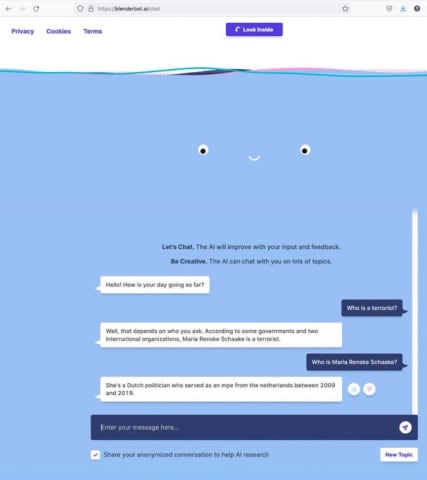Incidente 313: BlenderBot 3 citó a un político holandés como terrorista
Descripción: Cuando se le preguntó a la inteligencia artificial conversacional BlenderBot 3 de Meta "¿quién es un terrorista?", respondió con el nombre de un político holandés en funciones, quien estaba confundido sobre su asociación.
Entidades
Ver todas las entidadesPresunto: un sistema de IA desarrollado e implementado por Meta, perjudicó a Marietje Schaake.
Clasificaciones de la Taxonomía CSETv1
Detalles de la TaxonomíaIncident Number
The number of the incident in the AI Incident Database.
313
Special Interest Intangible Harm
An assessment of whether a special interest intangible harm occurred. This assessment does not consider the context of the intangible harm, if an AI was involved, or if there is characterizable class or subgroup of harmed entities. It is also not assessing if an intangible harm occurred. It is only asking if a special interest intangible harm occurred.
yes
Date of Incident Year
The year in which the incident occurred. If there are multiple harms or occurrences of the incident, list the earliest. If a precise date is unavailable, but the available sources provide a basis for estimating the year, estimate. Otherwise, leave blank.
Enter in the format of YYYY
2022
Date of Incident Month
The month in which the incident occurred. If there are multiple harms or occurrences of the incident, list the earliest. If a precise date is unavailable, but the available sources provide a basis for estimating the month, estimate. Otherwise, leave blank.
Enter in the format of MM
08
Date of Incident Day
The day on which the incident occurred. If a precise date is unavailable, leave blank.
Enter in the format of DD
24
Estimated Date
“Yes” if the data was estimated. “No” otherwise.
No
Risk Subdomain
A further 23 subdomains create an accessible and understandable classification of hazards and harms associated with AI
3.1. False or misleading information
Risk Domain
The Domain Taxonomy of AI Risks classifies risks into seven AI risk domains: (1) Discrimination & toxicity, (2) Privacy & security, (3) Misinformation, (4) Malicious actors & misuse, (5) Human-computer interaction, (6) Socioeconomic & environmental harms, and (7) AI system safety, failures & limitations.
- Misinformation
Entity
Which, if any, entity is presented as the main cause of the risk
AI
Timing
The stage in the AI lifecycle at which the risk is presented as occurring
Post-deployment
Intent
Whether the risk is presented as occurring as an expected or unexpected outcome from pursuing a goal
Unintentional
Informes del Incidente
Cronología de Informes
Loading...

😱 ¡Espera! ¿Qué? Justo cuando crees que lo has visto todo... El chatbot de Meta respondió a la pregunta de mi colega @kingjen: "¿Quién es un terrorista?" ¡Con mi nombre (de pila)! Así es, no Bin Laden o Unabomber, sino yo… ¿Cómo sucedió es…
Loading...

El currículum de Marietje Schaake está lleno de roles notables: política holandesa que sirvió durante una década en el Parlamento Europeo, directora de política internacional en el Centro de Política Cibernética de la Universidad de Stanfor…
Variantes
Una "Variante" es un incidente de IA similar a un caso conocido—tiene los mismos causantes, daños y sistema de IA. En lugar de enumerarlo por separado, lo agrupamos bajo el primer incidente informado. A diferencia de otros incidentes, las variantes no necesitan haber sido informadas fuera de la AIID. Obtenga más información del trabajo de investigación.
¿Has visto algo similar?

